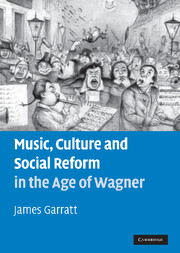Book contents
- Frontmatter
- Contents
- Acknowledgments
- Abbreviations
- Introduction
- 1 Liberalism, autonomy and the social functions of art
- 2 Radical and social aesthetics in the Vormärz
- 3 Speaking for the Volk: music, politics and Vormärz festivals
- 4 Revolutionary voices: blueprints for an aesthetic state
- 5 Music and the politics of post-revolutionary culture
- 6 The song of the workers: idylls and activism
- Notes
- Bibliography
- Index
2 - Radical and social aesthetics in the Vormärz
Published online by Cambridge University Press: 05 July 2011
- Frontmatter
- Contents
- Acknowledgments
- Abbreviations
- Introduction
- 1 Liberalism, autonomy and the social functions of art
- 2 Radical and social aesthetics in the Vormärz
- 3 Speaking for the Volk: music, politics and Vormärz festivals
- 4 Revolutionary voices: blueprints for an aesthetic state
- 5 Music and the politics of post-revolutionary culture
- 6 The song of the workers: idylls and activism
- Notes
- Bibliography
- Index
Summary
In different ways, the liberal standpoints on art's social functions encountered up to this point were shaped fundamentally by 1789 and its aftermath, whether through republican idealism or abhorrence at the violence of the revolutionary Terror. Yet if figures like Schiller and Nägeli were committed to the broader realizations of their ideals of personal and aesthetic autonomy, none held much expectation of the imminent transformation of society. In contrast, the two decades between the French Revolution of July 1830 and the European revolutions of 1848–9 threw up a mountain of essays, tracts and polemical pieces aiming to make art an engine for political change, or envisaging the kind of aesthetic community that would emerge following the expected social revolution. Left-liberal, radical republican and socialist commentators habitually dismissed the compromises of the previous generation, aiming to activate the emancipatory powers of the aesthetic or reconstruct society in order to enable their realization. The critique of Romanticism – often conceived broadly as a literary, social and political force of reaction – and particularly of Romantic aesthetic separatism is a common factor in these texts; similarly, these commentators shared the impulse to reject or move beyond the opposition of free art and political service art present in the aesthetics of Kant, Schiller and Hegel. Yet most of the varieties of social aesthetics encountered in this chapter do not simply refuse autonomy, either as a political or aesthetic concept; rather they aimed to socialize art and to draw out the social quality in each individual.
- Type
- Chapter
- Information
- Music, Culture and Social Reform in the Age of Wagner , pp. 44 - 83Publisher: Cambridge University PressPrint publication year: 2010
- 1
- Cited by



